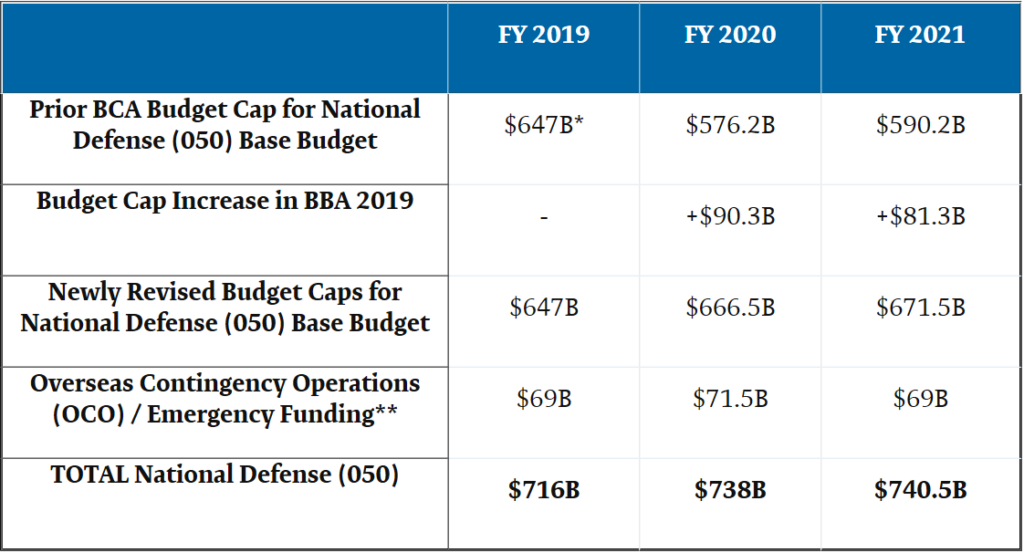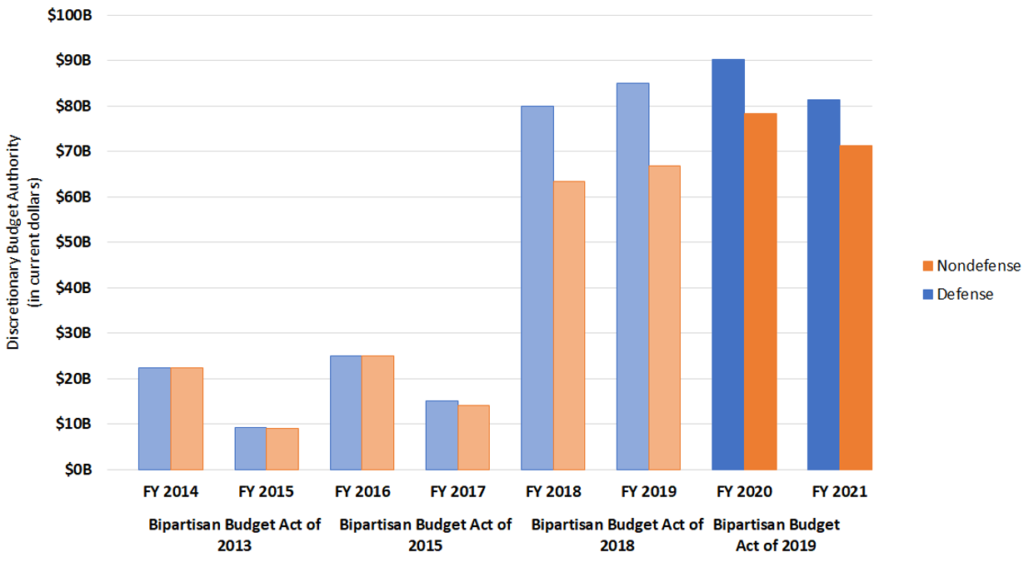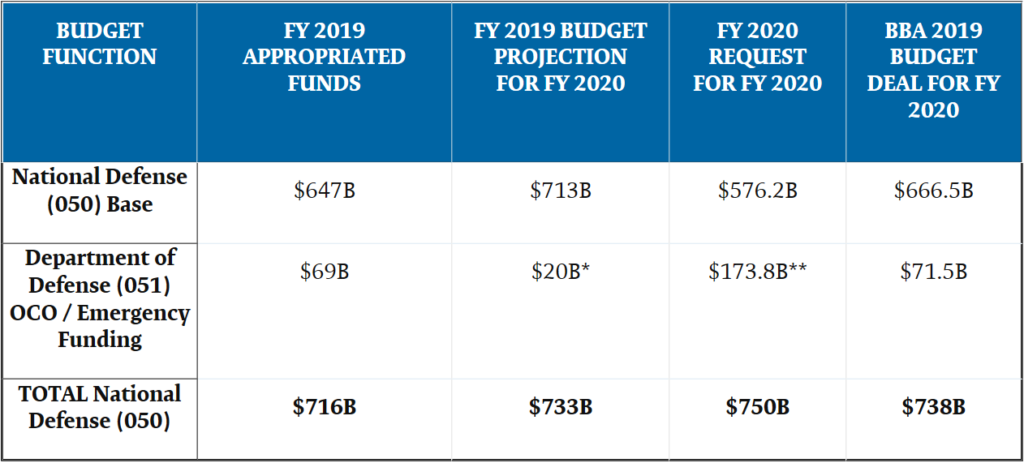What Does the Bipartisan Budget Act of 2019 Mean for Defense?

On August 2, President Trump signed H.R. 3877, the Bipartisan Budget Act of 2019 (BBA 2019), into law. The bill raises the 2011 Budget Control Act (BCA) budget caps for both defense and nondefense for FY 2020 and FY 2021, the final two years of the discretionary caps. The bill also suspends the debt ceiling through July 31, 2021 and extends cuts on certain mandatory programs from FY 2027 to FY 2029. Below are four critical questions about the budget agreement and its implications for national defense.
Q1: What does the funding deal include for defense?
A1: BBA 2019 is a two-year agreement that raises the budget caps for both defense and nondefense in FY 2020 and FY 2021. As shown in Table 1, the deal increases the defense cap for FY 2020 by approximately $90 billion above the previous cap of $576 billion and raises the FY 2021 budget cap of $590 billion by approximately $81 billion.
Table 1. Defense Funding Levels Under the Bipartisan Budget Act of 2018 (discretionary budget authority in current dollars)

* The budget cap for FY 2019 was raised from the original cap of $562.1 billion to $647.0 billion by the Bipartisan Budget Act of 2018.
** OCO and emergency supplemental funding does not count toward the budget caps.
BBA 2019 also specifies the funding levels for the Overseas Contingency Operations (OCO) account for FY 2020 and FY 2021. The original purpose of OCO was to fund the incremental costs of operations in Iraq and Afghanistan; however, due to its exemption from the budget caps under the BCA, the account has been used as a loophole to supplement funding for normal base budget defense activities and, to a lesser extent, nondefense State Department activities. The bill provides $71.5 billion in OCO for FY 2020 and $69 billion for FY 2021, bringing total national defense discretionary spending (050) to $738 billion and $740.5 billion, respectively.
Q2: How does this budget deal compare with previous deals?
A2: BBA 2019 marks the fifth budget agreement to adjust the budget caps imposed by the BCA, beginning with the American Taxpayer Relief Act (ATRA) of 2012. As a two-year deal that increases the spending limits for both defense and nondefense, BBA 2019 follows the pattern set by three previous agreements: the Bipartisan Budget Act of 2013 (BBA 2013), the Bipartisan Budget Act of 2015 (BBA 2015), and the Bipartisan Budget Act of 2018 (BBA 2018).
As shown below in Figure 1, BBA 2019 is most similar to BBA 2018 in terms of the magnitude of the deal. BBA 2019 increased the defense budget caps by approximately $172 billion for the FY 2020-2021 period while BBA 2018 increased the defense caps by $165 billion for FY 2018-2019. By comparison, BBA 2013 and BBA 2015 increased the defense caps by $32 billion and $40 billion for their respective two-year periods.
Figure 1. Comparison of Adjustments to the Budget Caps in Recent Budget Deals

While each of the budget deals since 2011 has raised both the defense and nondefense caps, BBA 2019 is again most similar to BBA 2018 in that it increases the defense caps more than the nondefense caps. As shown in Figure 1 above, BBA 2013 and BBA 2015—negotiated under a Democratic White House and a Congress that was divided in 2013 and controlled entirely by Republicans in 2015—provided near-equal increases in the budget caps for defense and nondefense. BBA 2018—passed when Republicans controlled both houses of Congress and the White House—raised the defense caps by roughly $35 billion more than the nondefense caps over FY 2018 and FY 2019. BBA 2019 increases the defense caps by $22 billion more than the nondefense caps over the two-year period. Additionally, each of the last four budget agreements relied on OCO to further increase defense spending levels (and to a significantly less extent nondefense levels) above the caps, though only BBA 2015 and BBA 2019 specifically mandated OCO levels in the text of the law.
Together, these budget agreements have ensured that the impact of the BCA caps on defense spending was less than originally specified. Figure 2 below depicts the original and revised budget caps relative to the Obama administration’s projections for base national defense spending in the FY 2012 budget request, the last budget submitted before the BCA was enacted. Between FY 2012 and FY 2021, total base defense spending under the original BCA caps was slated to be more than one trillion less than the FY 2012 budget request projections over the 10-year period. Subsequent budget agreements, however, raised the caps by a total of $435 billion over 10 years. In fact, base national defense spending has returned to levels close to those projected in the FY 2012 request with the revised FY 2021 cap only 4 percent lower than the projected level for FY 2021 in President Obama’s FY 2012 budget request.
Figure 2. Evolution of the BCA Budget Caps for Defense

Q3: What does the budget deal mean for defense funding in FY 2020 and FY 2021?
A3: Total national defense funding of $738 billion for FY 2020 under BBA 2019 represents real growth of 1 percent above FY 2019 appropriated levels. It is 1.6 percent less than the $750 billion requested by the Trump administration for FY 2020. However, $7.2 billion in the requested amount was designated as emergency funds for border wall construction. The $738 billion topline thus falls between the $743 billion for regular defense activities (including $2 billion in emergency funds for hurricane relief and recovery) in the FY 2020 request and the previously projected topline of $733 billion for FY 2020 included in the administration’s FY 2019 budget request.
Table 2. Comparing the Trump Administration’s FY 2020 Request with the revised FY 2020 Budget Caps ( discretionary budget authority in current dollars)

* The FY 2019 budget request planned to shift $53 billion of OCO funding to the base budget.
** The FY 2020 budget request shifted $98 billion in base funding to the OCO budget. This also includes $9 billion in emergency funding for border wall construction and hurricane relief and recovery.
One of the issues the BBA 2019 budget deal settles is the use of OCO funding. While the Trump administration had previously indicated in the FY 2019 budget request that it intended to move all OCO funding except $20 billion into the base defense budget, it reversed that policy in the FY 2020 budget request. Instead of moving OCO funding into the base budget, the administration proposed moving all base budget funding above the original budget cap level into OCO—not just for FY 2020 but for FY 2021 as well. The budget deal, however, prohibits the additional movement of base to OCO by specifying the level of OCO funding in law.
The timing of the BBA 2019 deal also means that Congress can, in theory, pass defense appropriations before the start of the fiscal year on October 1. This would be the first time since FY 2004-2005 that defense would have appropriations enacted before the beginning of the fiscal year for two years in a row. And because this is a two-year budget deal, it means Congress may also be able to pass appropriations on time for FY 2021, which would be the first time in at least 50 years for defense to have on-time appropriations three years in a row. However, the mere fact that a budget deal is in place does not guarantee that the appropriations process will proceed smoothly. For example, while a budget deal was already in place months in advance for FY 2019, parts of the federal government did not have appropriations enacted on-time and experienced an extended lapse in appropriations (i.e., a partial government shutdown) for part of the year.
Figure 3. Delays in Defense Appropriations, FY 1969-2019

Q4: What does the budget deal mean for the future of U.S. defense spending?
A4: The BBA 2019 budget deal is effectively the end of the BCA for defense. It adjusts the caps through FY 2021 (the last year of the discretionary caps) to a level both parties in Congress and the White House have deemed acceptable. While technically a sequester could still be triggered if the caps are breached, it is highly unlikely that Congress would enact appropriations that breach the newly agreed-to caps.
Under current law, there are no caps on defense and nondefense discretionary spending for FY 2022 and beyond. While this means there is no longer a statutory ceiling on spending, the BCA budget caps did not act as a ceiling in practice. Rather, the budget caps acted as a floor for the budget and the baseline from which deals were negotiated. In every year that the budget caps were in effect, the budget caps were increased above their original level and the budget never dropped below the original level of the budget caps. And the dichotomy of having separate defense and nondefense caps created points of leverage for both sides in the debate to strike a bipartisan compromise. The de facto practice that emerged after the passage of the BCA was a two-year budget setting process that manifested itself, albeit slowly and with much angst, in the BBA 2013, BBA 2015, BBA 2018, and BBA 2019 budget deals.
After FY 2021, there will be no ceiling on the defense budget and no floor. The structure and timing of negotiations that the BCA created since 2011 will no longer exist, and Congress will be left to return to regular order in the budget process. Regular order, however, is something with which the current Congress and White House have little practice or experience.
For an analysis of the prior budget deal and its implications on defense spending, see “Making Sense of the Bipartisan Budget Act of 2018 and What It Means for Defense.”
Critical Questions is produced by the Center for Strategic and International Studies (CSIS), a private, tax-exempt institution focusing on international public policy issues. Its research is nonpartisan and nonproprietary. CSIS does not take specific policy positions. Accordingly, all views, positions, and conclusions expressed in this publication should be understood to be solely those of the author(s).
© 2019 by the Center for Strategic and International Studies. All rights reserved.
(Photo by the Architect of the Capitol)

